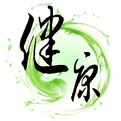
Traditional Chinese Medicine (TCM) classifies individuals into nine basic body constitutions: Pinghe (Balanced), Qixu (Qi Deficiency), Yangxu (Yang Deficiency), Yinxu (Yin Deficiency), Tan Shi (Phlegm-Damp), Shire (Damp-Heat), Xueyu (Blood Stasis), Qiyu (Qi Stagnation), and Tebing (Special Constitution). Each constitution type has distinct characteristics in terms of physical traits, physiological features, psychological traits, pathological responses, and disease tendencies.
Different Characteristics of the Nine Body Constitutions
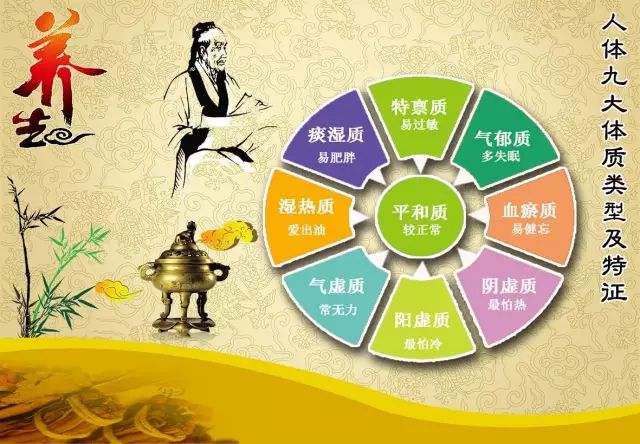
1. Pinghe Constitution
Characteristics: Individuals with this constitution have a well-proportioned and robust physique, a rosy complexion, smooth skin, thick and shiny hair, bright eyes, rosy lips, and are not easily fatigued. They have abundant energy, good sleep, normal appetite, regular bowel movements, and a cheerful and easy-going personality.
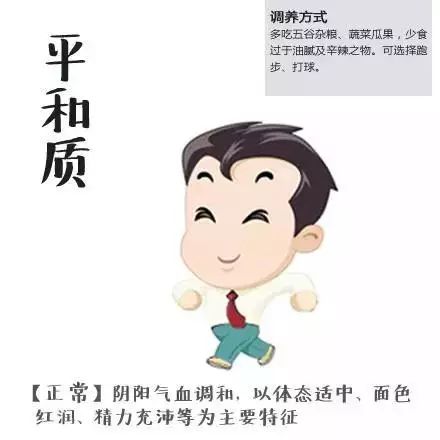
Maintenance: Pay attention to a balanced diet, combine work and rest, maintain regular exercise, avoid overeating or undereating, and consume food at moderate temperatures. Emphasize whole grains, vegetables, and fruits while minimizing greasy and spicy foods.
2. Qiyu Constitution
Characteristics: Prone to sudden outbursts of anger or feelings of melancholy, with a pale complexion. Individuals are often thin, frequently feel gloomy, and may experience palpitations and insomnia. They are easily startled or frightened, often feeling breast and side pain, and have a sensation of obstruction in the throat, leading to insomnia. This constitution is associated with a higher risk of depression, neurosis, and breast hyperplasia.
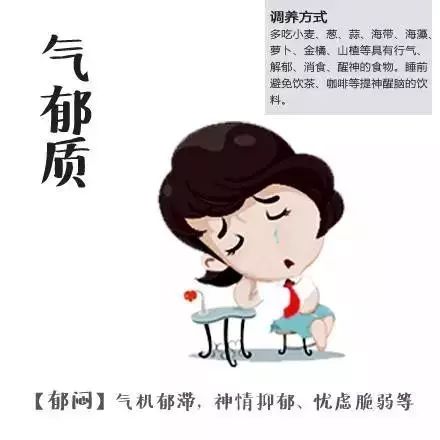
Maintenance: Consume foods that promote Qi circulation and relieve stagnation, such as wheat, scallions, garlic, kelp, radishes, kumquats, and hawthorn. Formulas like Xiao Yao San (Free and Easy Wanderer) and Shu Gan He Wei Wan (Liver and Stomach Harmonizing Pill) can be used for regulation. Minimize late nights to ensure quality sleep.
3. Xueyu Constitution
Characteristics: Individuals often have a dark complexion, bluish lips, and purple veins under the tongue; their fingernails may appear dark purple. They may experience a stasis pulse, indicating poor blood circulation. Symptoms include bleeding gums, red eyes, dry skin, frequent pain, irritability, forgetfulness, and a tendency to develop bruises without apparent cause.
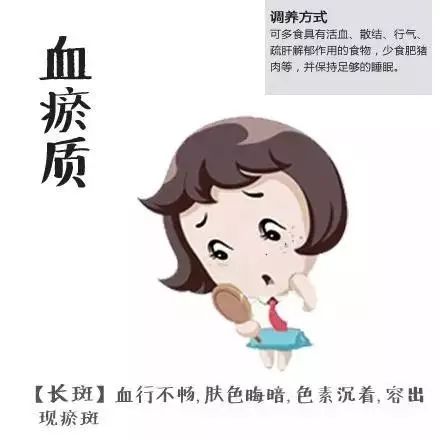
Maintenance:
1. Regularly consume foods that invigorate blood and dispel stasis, such as Buddha’s Hand (Fo Shou), black fungus (He Mu Er), peach kernels (Tao Ren), and lotus root (Luo Bo). Moderate alcohol consumption and incorporating vinegar into meals can also be beneficial.
2. Blood tends to accumulate in the extremities; regular massage of the head, face, and feet can help disperse stasis.
3. Cultivating an optimistic mindset is essential, as a joyful spirit promotes smooth Qi and blood flow, improving the Xueyu constitution.
4. Yinxu Constitution
Characteristics: Individuals often experience heat in the palms and soles, flushed cheeks, dry skin, dry mouth and throat, red tongue with little coating, and may suffer from night sweats. They may also experience dry eyes, dizziness, and weakness in the lower back and knees, often presenting a thin physique. Those with Yinxu constitution should be cautious of hyperthyroidism and other related diseases.
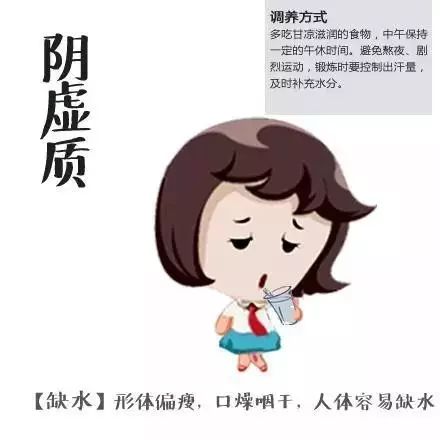
Maintenance:
1. Consume cooling and moistening foods such as mung beans, winter melon, sesame, and lily bulbs. Avoid warming and drying foods like lamb, dog meat, leeks, chili, scallions, and garlic.
2. Avoid saunas and high-temperature environments.
3. Consider using formulas like Liu Wei Di Huang Wan (Six Flavor Rehmannia Pill) and Qi Ju Di Huang Wan (Goji and Chrysanthemum Rehmannia Pill) as needed.
5. Yangxu Constitution
Characteristics: Individuals often feel cold, experience tinnitus, lower back pain, insomnia, irritability, frequent urination, loose stools, and clear, copious urine. Severe Yangxu may lead to digestive issues, weakness in the lower back and knees, and even skin blemishes. They tend to have a calm and introverted personality.
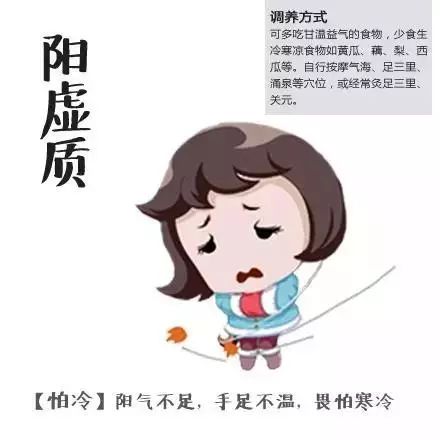
Maintenance:
1. Consume warming and Qi-boosting foods such as beef, lamb, chicken, scallions, ginger, garlic, Sichuan pepper, leeks, and chili.
2. Minimize consumption of cold and raw foods like cucumbers, lotus root, pears, and watermelons.
3. Keep warm and avoid prolonged exposure to air conditioning. Engage in outdoor activities in sunny weather and avoid wind and cold during exercise.
4. Self-massage points like Qihai (CV6), Zusanli (ST36), and Yongquan (KD1) or perform moxibustion on Zusanli and Guanyuan (CV4).
6. Qixu Constitution
Characteristics: This constitution is characterized by weakness and lethargy. Common symptoms include fatigue, mental exhaustion, shortness of breath, susceptibility to colds, pale tongue with white coating, and weak pulse. Individuals with Qixu constitution are prone to colds and have a weak recovery ability after illness, often experiencing organ prolapse such as gastric ptosis.
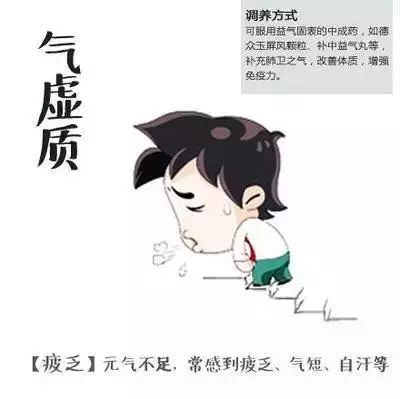
Maintenance:
1. Consume foods that tonify Qi and strengthen the spleen, such as yellow beans, white broad beans, shiitake mushrooms, jujubes, longan, and honey. Add ginseng, astragalus, codonopsis, poria, yam, lingzhi (Reishi), and jujubes when cooking porridge or soup.
2. Avoid foods that deplete Qi, such as water spinach and raw radishes.
3. Maintain a regular lifestyle, ensuring adequate rest during summer afternoons and keeping warm to avoid excessive sweating during labor or intense exercise.
4. Engage in gentle exercises like walking or Tai Chi, and regularly massage Zusanli (ST36) point.
7. Shire Constitution
Characteristics: Individuals often have a thick yellow tongue coating, oily skin, and are prone to acne and skin itching. They frequently feel heavy and fatigued, may experience recurrent mouth ulcers, bitter taste, bad breath, and sticky stools. Urine may appear yellow, and irritability is common. Women may experience yellowish vaginal discharge.
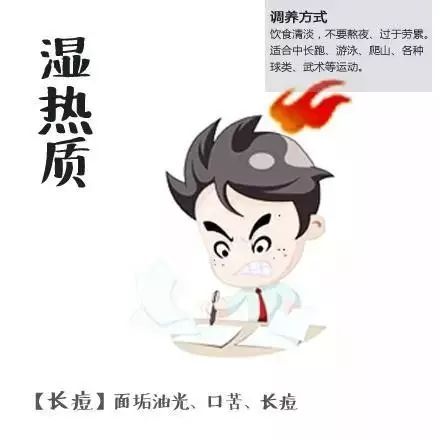
Maintenance:
1. Maintain a light diet, consuming cooling and bland foods while avoiding rich, spicy, and hot foods.
2. Avoid smoking and drinking alcohol. Do not stay up late or overwork.
3. Keep living conditions dry and ventilated, reducing outdoor activity during hot summer months.
4. Engage in high-intensity exercises such as long-distance running, swimming, climbing, and various ball sports.
5. Regularly take formulas like Liu Yi San (Six One Powder), Qing Wei San (Clear Stomach Powder), and Gan Lu Xiao Du Dan (Sweet Dew Detox Pill).
8. Tan Shi Constitution
Characteristics: Individuals often have oily skin, excessive sweating, puffy eyes, and a heavy feeling in the body. They may experience fatigue, joint pain, numbness, and a sticky or sweet taste in the mouth. They often have phlegm in the throat, and their tongue coating is thick. Lips may appear pale, and they may have a poor appetite and digestive issues.
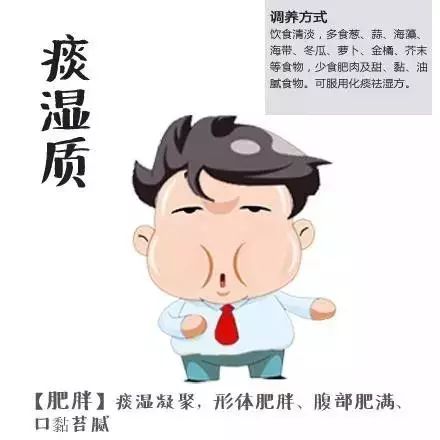
Maintenance:
1. Maintain a light diet, focusing on foods that strengthen Qi and consolidate the exterior, such as scallions, garlic, seaweed, winter melon, radishes, kumquats, and mustard.
2. Avoid buckwheat (which contains allergenic substances), fatty meats, and sweet, sticky, or greasy foods.
3. Ensure a dry living environment and engage in outdoor activities. Regular sun exposure or sunbathing is beneficial. Reduce outdoor activities in damp and cold weather.
4. Exercise should be gradual and consistent, tailored to individual circumstances.
9. Tebing Constitution
Characteristics: Individuals with this rare constitution are prone to allergies, frequent colds, and nasal congestion, especially in older adults who may develop asthma. Their skin is susceptible to urticaria, and they may bruise easily without scratching.
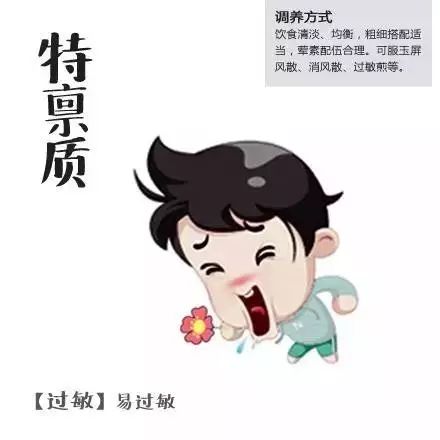
Individuals with this constitution should focus on a light diet, balancing coarse and fine foods, and limit soy products. Avoid excessive coffee and strong tea. Living spaces should be free from allergens, and homes should have windows for ventilation. Maintain regular meal and sleep schedules, and engage in regular exercise while keeping warm.
Not all health maintenance methods are suitable for everyone. Different body constitutions require different approaches to health management. Only methods tailored to one’s constitution can achieve better health outcomes. I hope everyone can achieve good health from the inside out!
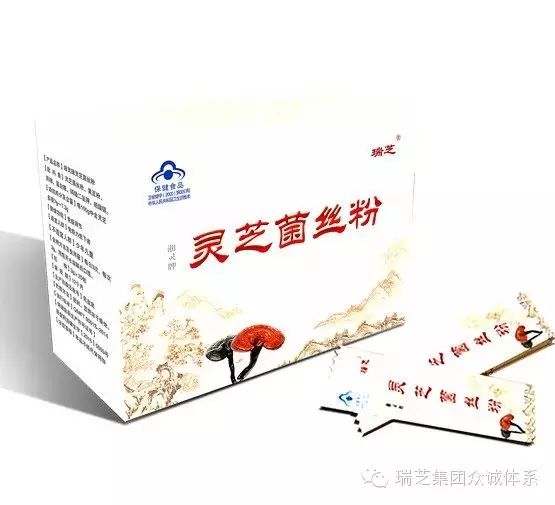
Pharmacological Activities and Functions of Lingzhi (Reishi Mushroom):
1. Immune Regulation
2. Enhancing Hypoxia Tolerance
3. Anti-Aging Effects
4. Antioxidant Effects
5. Blood Sugar Reduction
6. Blood Pressure Reduction
7. Anti-Allergic Effects
8. Anti-Inflammatory Effects
9. Regulation of Nucleic Acid and Protein Metabolism
10. Promotion of DNA Synthesis
11. Radioprotective Effects
Clinically Used for the Treatment of the Following Diseases:
1. Chronic Bronchitis
2. Coronary Heart Disease
3. Hepatitis
4. Lipid Reduction
5. Neurasthenia
6. Adjuvant Therapy for Cancer Patients
7. Leukopenia
8. Scleroderma, Dermatomyositis, Lupus Erythematosus
9. Muscular Dystrophy, Myotonia
10. Anti-Aging, Detoxification, and Beauty
Common diseases have unique preventive and conditioning effects.
1. Conditioning the Digestive System 2. Conditioning the Nervous System 3. Conditioning the Cardiovascular System 4. Conditioning the Respiratory System 5. Conditioning the Urinary System 6. Conditioning the Endocrine System
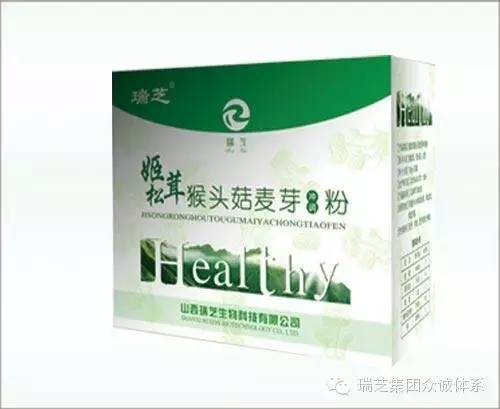
Effects of Matsutake Mushroom:
1. Anti-Cancer: Matsutake mushrooms have effects such as strengthening the body, benefiting the stomach, relieving pain, and resolving phlegm. Modern scientific research indicates that Matsutake also has special effects in treating diabetes and cancer, making it a leading anti-cancer fungus. 2. Immune Enhancement: It can enhance immunity, lower blood sugar, strengthen the heart, regulate blood pressure, prevent thrombosis, and combat viruses. Children who consume fresh mushrooms may also benefit dental health. 3. Anti-Tumor.

